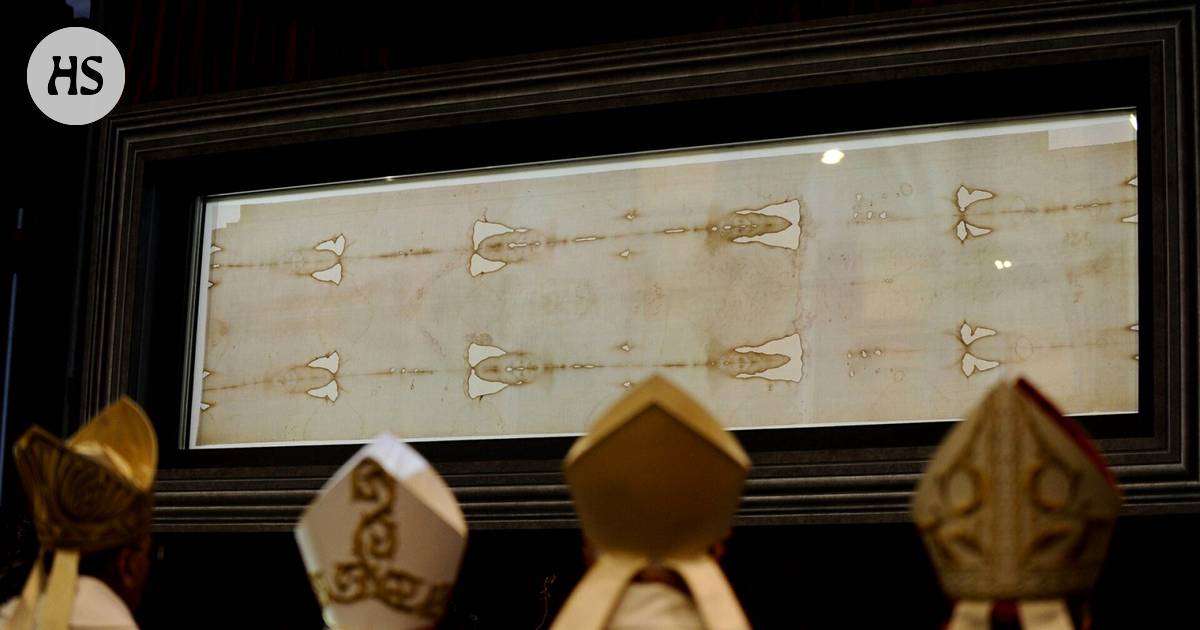Recent dating studies bring the Shroud of Turin close to the time of Jesus.
of Turin a cathedral in northern Italy keeps a cloth traditionally revered by pilgrims of Jesus as a shroud. In recent decades, its background has been investigated using the methods of both natural sciences and historical research.
The figure of a man, both the back and the front, can be seen quite dimly on the approximately four-meter-long linen cloth. The bodies show traces of torture: nail marks on the wrists and feet, a puncture wound on the side and wounds on the head. There are small traces of blood drops on the fabric.
The injuries correspond to those that occurred during the crucifixion of Jesus. They are otherwise typical of the violent execution method of the Romans, but the head wounds match Jesus' crown of thorns. Such was not part of the usual customs.
The Shroud of Turin has been suspected of being a fake made in the 14th century. And no wonder, because the cloth was brought to pilgrims to see in Lirey, France, in the middle of the 14th century – without any clarity as to how it had ended up there. On the other hand, the latest studies date it close to the time of Jesus.
Picture is a negative, which was not revealed until 1898. At that time, an Italian amateur photographer Secondo Pia got permission to photograph the shroud – and in the negative image drawn on the glass plate, the face was much clearer than on the cloth itself.
“The true essence of the wrapping cloth has only been revealed through modern and interdisciplinary cutting-edge research,” says Juha Hiltunen.
Hiltunen's book Photo of Jesus (2019) is the most recent work in Finnish on the subject. Hiltunen himself is a docent of anthropology at the University of Oulu, with an academic background as a cultural historian and anthropologist.
In the Gospels of Luke and John, it is said that after the resurrection of Jesus, a shroud without a body was found in the rock tomb. The New Testament does not say where the shroud ended up.
In the year 1988 The Shroud of Turin was radiocarbon dated, which received a lot of international publicity. Based on that, the shroud was dated to the 14th century.
Later, the timing has been criticized because a newer substance could have attached to the fabric over time. According to Hiltunen, it is also possible that the fabric was carefully and almost invisibly repaired in the Middle Ages – and the cutter of the sample piece hit just such a spot.
The freshest the timing study was done by an Italian research group. The results have been published In Heritage Science in 2022.
In this study, the linen sample from the Shroud of Turin was the best match with a linen material from the Masada fortress on the shores of the Dead Sea and dated to between 55 and 75 AD. The timing therefore falls very close to the death of Jesus around the year 30.
(The Shroud of Turin's) carbon-14 dating results are controversial, especially due to the probable carbon contamination of the textile. Its importance is not insignificant”, assesses the article in the Heritage publication.
On the homepage www.shroud.com there is plenty of research related to the shroud from various fields. There are also a few texts that sharply criticize research colleagues and suspect their motives.
Part The stages of the Shroud of Turin are well known, some much worse. If those close to Jesus recovered the shroud, they had good reasons to hide it from thieves and adversaries.
Later, the shroud seems to have ended up north of Jerusalem: in Antioch in Syria and after that in Edessa. Both cities were important metropolises of their time and are located in the territory of present-day Turkey.
The national treasure of the Byzantine Empire was the cloth Mandylion, a “handmade” image of Christ and a prototype of Christ icons. It was moved to Constantinople in 944 from Edessa, where it had been kept for hundreds of years.
During the sack of Constantinople in 1204, Mandylion disappeared without a trace. One guess is that it ended up on the Doge of Venice's ship, which subsequently sank.
Juha Hiltunen says in his book A photo of Jesusthat recently several historians studying the stages of the Shroud have come to the conclusion that the Mandylion is the same fabric that is now known as the Shroud of Turin.
In 1355 a knight Geoffrey de Charny brought the shroud for pilgrims to see in the small church he had built in the village of Lirey. His spouse was Jeanne de Vergy. Ancestor of this one Othon de la Roche participated in the sack of Constantinople and is the strongest suspect to have taken possession of the Mandylion.
Later, the shroud ended up in the Savoy princely family, who in 1578 placed it in the Turin cathedral.
Descendants of the family included the last king of united Italy Umberto IIwho went into exile in 1946 and died in 1983. In his will, he ordered that the Shroud be owned by the Vatican and kept in Turin.
#Italy #cloth #Turin #Cathedral #Shroud #Jesus #excellent #fake








